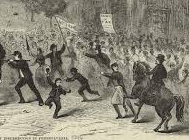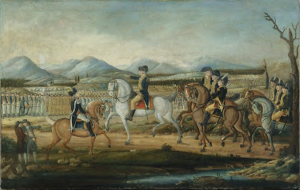The American colonists had protested long and loudly against taxes instituted by the British government in order to help pay off debts incurred in fighting the French and Indian War. The Stamp Act and the Townshend Acts laid out plans for taxing china, glass, lead, paint, paper, and tea. Parliament eventually repealed all of those taxes. The colonists didn't like the idea of a tax just to generate revenue; even more, they passionately resented the idea of "taxation without representation." The American victory in the Revolutionary War cemented the new country's existence, and the Founding Fathers set about creating a new form of government. After a brief stint of a loose-central-government framework under the Articles of Confederation, the attendees at the Constitutional Convention created a new stronger-central-government framework embodied in the Constitution. The new government faced a familiar problem, however: debt. Each of the individual states had debts. Alexander Hamilton, the first Secretary of the Treasury, won his argument with other members of the Cabinet over whether the federal government should assume all states debts. The federal government had other bills to pay as well, and so Hamilton, one of the leaders of the Federalist Party, searched for other forms of revenue. One Federalist priority was an excise tax, which was paid by producers, not consumers. The Constitution directly gave the Government the power to collect taxes. Seeking to start the Government off on a firm footing, Hamilton recommended excise taxes on rum, sugar, tobacco, and whiskey. Only the last one proved unpopular, resulting in the Whiskey Rebellion. 
The federal government passed the bill creating the tax in 1791. At this time and certainly before and for a time afterward, farmers living in western Pennsylvania were physically divorced from their fellow Pennsylvanians in the eastern part of the state by the Allegheny Mountains. As in other states, farming was the dominant occupation; because of the geographical isolation, these farmers had a limited market for the grain that they grew because transporting the grain over the mountains to the east was problematic and expensive. As a result, many western Pennsylvania farmers converted their grain to whiskey, for two reasons: it brought in more money, and it was slightly easier to transport and preserve. Whiskey wasn't just for drinking at this time. Some people used it for cooking; others used it as medicine. The tax on distilled spirits was unpopular for a few reasons:
Farmers in western Pennsylvania, many of them who fought in the Revolutionary War, were still struggling with attacks from Native American tribes at this time and felt that the federal government wasn't providing support. The whiskey tax added to that sense of frustration. Also, they were used to paying some of their bills using barter, in some cases paying with whiskey, which they sometimes had in abundance, instead of money. Not long after Hamilton introduced the tax, some farmers refused to pay it. The civil disobedience continued for several months and at times turned violent, as farmers attacked tax collectors; some were even tarred and feathered. In May 1794, several dozen farmers were under subpoena to appear in federal court, which was in Philadelphia, in order to explain why they weren't paying the tax. Congress changed the tax law slightly so that farmers could appear in local state courts, but it was too late for some farmers who had already been told that they had to go east. In the heat of summer, things turned nasty. 
Federal Marshal David Lenox and tax inspector John Neville had arrived on the farm of Oliver Miller, who lived not far from Pittsburgh. Shots were fired, and the marshal and tax inspector left. Neville went to his home, and Lenox went back to Pittsburgh. The next day, a few dozen members of a local militia visited Neville at his home and demanded that he hand over Lenox. Neville's response was to fire a warning shot, which struck Miller, the farmer he had visited just the day before; Miller died from the wound. The militiamen left but returned the next day, led by Revolutionary War veteran James McFarlane and boasting numbers exceeding 600. Supporting Neville were a small group of U.S. troops, led by Major Abraham Kirkpatrick. (Neville had slipped away, but the soldiers were still in his house when the large group of militiamen arrived.) A firefight ensued, and several men were killed. After about an hour, McFarlane, leader of the militia, called for a cease-fire. He stepped out into the open to plead for negotiations and was shot and killed. The militiamen responded by torching Neville's house. Kirkpatrick and his men surrendered. The violence continued. The following month, a group protesting the whiskey tax robbed the U.S. mail delivery. The call went out for all who wished to join the protest to meet, on August 1 at Braddock's field. More than 7,000 appeared on that day. Many of those people were neither farmers nor landowners; rather, the movement had gathered steam and involved people who identified with the cause even though they weren't personally affected by the tax. People at the gathering discussed various options for what to do next. Some suggested targeting homes and land owned by wealthy people. Some suggested declaring their part of the state to be independent from the U.S. President George Washington ordered the protesters to stop their low-level insurrection and was rebuffed. He then formed a peace commission to meet with the protesters. Pennsylvania Senator James Ross and Supreme Court justice Jasper Yeates met with the protesters for a few days in late August and late September. Negotiations did not produce an agreement. Eventually, Washington called out the federal militia. Under the Militia Act of 1792, the President could appropriate members of state militia to serve under federal command. The call went out to the governors of Maryland, New Jersey, Pennsylvania, and Virginia, requesting a force as large as 13,000. Few volunteered initially, and the federal government instituted a draft in order to fill the ranks. 
The force gathered at Carlisle, Penn., and Washington himself led the federal militia over the Allegheny Mountains to the town of Bedford, a journey that lasted nearly a month. (He remains the only President to lead troops in the field.) They arrived in late October. The protest movement had lost momentum by this time. Some persisted, however. Federal troops had arrested 150 by mid-November; 20 of those were leaders of the insurrection. Washington ordered pardons for all but 33 of those arrested. Only a few of those arrested were tried, and only two of those were convicted. (Those two were later pardoned as well.) The Whiskey Rebellion, as it became known, had ended. Congress repealed the excise tax on distilled spirits in 1802, along with all other internal federal taxes. One of the people who helped end those taxes was Albert Gallatin, a leading Pennsylvania businessman who had served on the committee of protesters that met with Washington's peace commission. Gallatin was Secretary of the Treasury at the time that the taxes were repealed. The episode validated the federal government's right to pass laws, including tax laws, that applied to all of its citizens. The federal government had also demonstrated that it could maintain order and its primacy. |
|
Social Studies for Kids
copyright 2002–2026
David White




